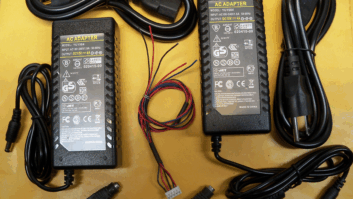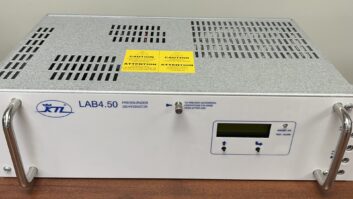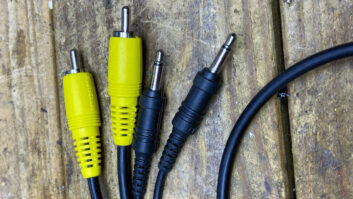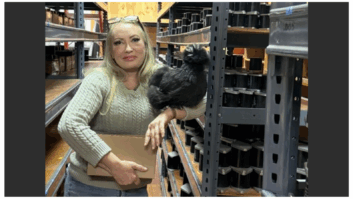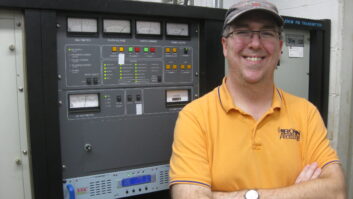Over the course of his career, Harry Simons has worked in numerous roles: on the air, as a chief, as a director of engineering and in station management. So it’s not so unusual that in retirement Harry chose to build a studio in his living room, shown here.
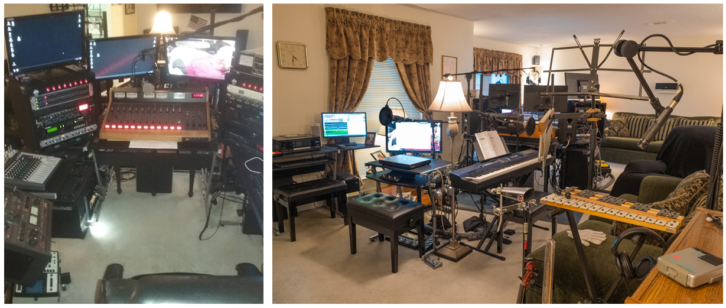
In addition to a Radio Systems console, Harry has added a variety of recording equipment and a Musician’s Pit; see the second photo.
Harry produces and mixes tracks for local groups, as well as music for a Part 15 carrier current/internet station he programs.
It’s true: Once broadcasting is in your blood, it never really leaves — even in retirement.
Harry can be reached at [email protected].
[Check Out More of Workbench Here]
Potential gotcha
Dave Kline — who describes himself as a solder jockey — writes to comment on our discussion of 3.5 mm TRRS (Tip-Ring-Ring-Sleeve) connectors as used in computer audio wiring, and the potential “gotcha.”
Not only might the ground/common/shield not be where you expect it, but its location may differ depending on the device. Dave ran into this when trying to interface audio with Apple iOS devices and other devices such as ones from Samsung.
He found that there are at least two different “standards.” Most notably, the common, which is on one of the rings shown in our previous column, might be on the shield for other devices.
Dave found an explanation that included drawings. Google “Mashtips Apple headphone” and look for the story headlined “Apple Headphone on Android Is Not Working …”
The “standard” that uses ground on the shield not only seems intuitive but is more compatible with common TRS (Tip-Ring-Sleeve) wiring.
If we have at least two “standards” for wiring TRRS connectors, who knows how many more might be lurking in the dark to make our day more interesting? Great point, Dave.
I should add that Dave began his email with an appropriate quote from Andrew S. Tanenbaum, an American-Dutch computer scientist: “The good thing about standards is that there are so many to choose from.” (For you old-timers, think “AM Stereo.”)
A note about pins
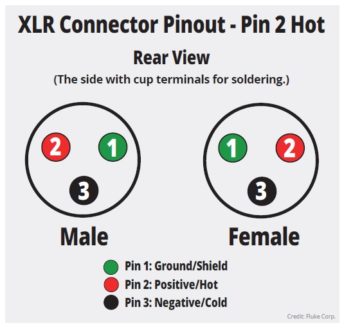 Following up on our “Pin 1 is ground” discussion in December, here are a couple things to remember when wiring up an XLR connector.
Following up on our “Pin 1 is ground” discussion in December, here are a couple things to remember when wiring up an XLR connector.
First, although soldering wires to the pins on an XLR connector is straight-forward, when you observe the pin numbers imprinted on the connector, keep in mind that the location of “Pin 1” flips from left to right (or vice versa) depending on the sex of the XLR.
A common mistake is to wire all the terminals the same, regardless of the sex of the connector (Male A3M or Female A3F). Since Pin 1 is ground and Pin 2 (next to it) is the hot or “+” you should refer to the pin numbers embossed or printed on the connector. See the accompanying diagram.
Oh, and before you begin soldering, don’t forget to slip the XLR cover over the wires!
A nifty specialty tool
There’s nothing more frustrating than radiofrequency interference. But when RFI affects airport communications, the problem is no longer just a nuisance. It must be corrected quickly.
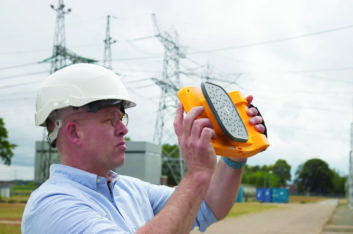
In the case of Rotterdam The Hague Airport in the Netherlands, interference was coming from an arcing electrical substation. The problem was resolved with the help of a Fluke ii910 Precision Acoustic Imager, which was developed to help engineers detect and identify such sources of electrical discharge. (It can also be used to detect air leaks.)
The handheld ii910 has a 7-inch LCD touchscreen that displays the results of an array of integral microphones that convert ultrasonic signals into clear visual images. It quickly diagnosed the source of the problem at the substation.
Read more about this device and the problem it corrected at the airport. At fluke.com, search “The Hague.”
Vista meravigliosa!
A reader wrote in to ask, “Could someone identify the location of that mountaintop community tower site in the photograph included with the article ‘Time to Plan for Old Man Winter’ in your Oct. 13 publication? It reminds me of Tiger Mountain east of Seattle.”

Radio World Editor-in-Chief Paul McLane replies that the photo in fact shows towers atop Paganella, a mountain in the Trentino-Alto Adige/South Tyrol region of the Italian Alps.
Have you been there? Tell us about it at [email protected]. And other great tower site photos welcome!
Plant a seed in our garden of ideas, and help a colleague at the same time. Send your tips and ideas to [email protected].
John Bisset, CPBE, has been in broadcasting more than 50 years and is in his 31st year writing Workbench. He handles western U.S. radio sales for the Telos Alliance and is a past recipient of the SBE’s Educator of the Year Award.

